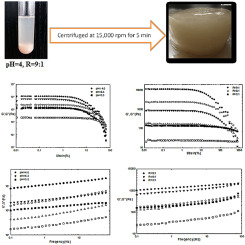当前位置:
X-MOL 学术
›
Food Hydrocoll.
›
论文详情
Our official English website, www.x-mol.net, welcomes your
feedback! (Note: you will need to create a separate account there.)
Rheological and structural properties of rice bran protein-flaxseed ( Linum usitatissimum L.) gum complex coacervates
Food Hydrocolloids ( IF 11.0 ) Pub Date : 2018-10-01 , DOI: 10.1016/j.foodhyd.2018.05.019 Elham Hasanvand , Ali Rafe
Food Hydrocolloids ( IF 11.0 ) Pub Date : 2018-10-01 , DOI: 10.1016/j.foodhyd.2018.05.019 Elham Hasanvand , Ali Rafe

|
Abstract Complex coacervation of protein/polysaccharide mixtures has obtained considerable research in the encapsulation of bioactive materials. The rheological properties of the coacervates of rice bran protein/flaxseed gum (RBP/FG) at different pH values including 3.3, 4.0 and 5.3 and varying protein to polysaccharide ratios 3:1, 6:1 and 9:1 were investigated using small amplitude oscillatory shear (SAOS). Moreover, the interrelationship between the ζ-potential, FTIR and viscoelastic properties of the samples was studied. The coacervates showed shear-thinning phenomenon due to the linear reduction of complex viscosity (η*) by increasing frequency. Furthermore, the highest complex modulus (G*) and more compact coacervate structure were obtained at pH = 4.0, revealing less deformability and flow behavior. All the coacervates showed higher storage modulus (G′) than loss modulus (G″) indicating the formation of highly interconnected gel-like structure and were fitted by the Power law model. The maximum fracture stress was obtained at pH 4.0 revealing the highest intermolecular interactions between RBP and FG. The absolute ζ-potential of the coacervate at pH 4.0 and R = 9:1 was close to 0 and less than the other samples in which the highest fracturability and gel strength of the complex coacervate was achieved. It seems this property of the coacervate would be suitable for encapsulation of bioactive materials. The high aggregation of coacervates at pH 4.0 makes them more readily neutralized by protein binding. FTIR results showed that the spectrum of the coacervate was different from each individual biopolymer, related to their compatibility and intermolecular interactions between the functional groups of RBP and FG. Consequently, RBP/FG coacervates can be managed to some extent to achieve proper textural properties in dairy formula through manipulating pH and biopolymer mixing ratio.
中文翻译:

米糠蛋白-亚麻籽 (Linum usitatissimum L.) 胶复合凝聚层的流变学和结构特性
摘要 蛋白质/多糖混合物的复杂凝聚在生物活性材料的包封中得到了大量研究。使用小振幅研究米糠蛋白/亚麻籽胶 (RBP/FG) 在不同 pH 值(包括 3.3、4.0 和 5.3)以及不同蛋白质与多糖比例 3:1、6:1 和 9:1 下的流变特性振荡剪切 (SAOS)。此外,还研究了样品的 ζ 电位、FTIR 和粘弹性之间的相互关系。由于复数粘度 (η*) 随频率增加而线性降低,凝聚层表现出剪切稀化现象。此外,在 pH = 4.0 时获得了最高的复数模量 (G*) 和更紧凑的凝聚层结构,显示出较小的变形性和流动行为。所有凝聚层的储能模量 (G') 均高于损耗模量 (G"),表明形成了高度互连的凝胶状结构,并通过幂律模型拟合。在 pH 4.0 下获得最大断裂应力,表明 RBP 和 FG 之间的分子间相互作用最高。凝聚层在 pH 4.0 和 R = 9:1 时的绝对 ζ 电位接近于 0,并且小于其他样品,其中复合凝聚层的破裂性和凝胶强度最高。似乎凝聚层的这种特性适用于生物活性材料的包封。pH 4.0 时凝聚层的高度聚集使它们更容易被蛋白质结合中和。FTIR 结果表明凝聚层的光谱与每个单独的生物聚合物不同,与 RBP 和 FG 的官能团之间的相容性和分子间相互作用有关。因此,可以在一定程度上控制 RBP/FG 凝聚层,通过控制 pH 值和生物聚合物混合比,在乳制品配方中获得适当的质地特性。
更新日期:2018-10-01
中文翻译:

米糠蛋白-亚麻籽 (Linum usitatissimum L.) 胶复合凝聚层的流变学和结构特性
摘要 蛋白质/多糖混合物的复杂凝聚在生物活性材料的包封中得到了大量研究。使用小振幅研究米糠蛋白/亚麻籽胶 (RBP/FG) 在不同 pH 值(包括 3.3、4.0 和 5.3)以及不同蛋白质与多糖比例 3:1、6:1 和 9:1 下的流变特性振荡剪切 (SAOS)。此外,还研究了样品的 ζ 电位、FTIR 和粘弹性之间的相互关系。由于复数粘度 (η*) 随频率增加而线性降低,凝聚层表现出剪切稀化现象。此外,在 pH = 4.0 时获得了最高的复数模量 (G*) 和更紧凑的凝聚层结构,显示出较小的变形性和流动行为。所有凝聚层的储能模量 (G') 均高于损耗模量 (G"),表明形成了高度互连的凝胶状结构,并通过幂律模型拟合。在 pH 4.0 下获得最大断裂应力,表明 RBP 和 FG 之间的分子间相互作用最高。凝聚层在 pH 4.0 和 R = 9:1 时的绝对 ζ 电位接近于 0,并且小于其他样品,其中复合凝聚层的破裂性和凝胶强度最高。似乎凝聚层的这种特性适用于生物活性材料的包封。pH 4.0 时凝聚层的高度聚集使它们更容易被蛋白质结合中和。FTIR 结果表明凝聚层的光谱与每个单独的生物聚合物不同,与 RBP 和 FG 的官能团之间的相容性和分子间相互作用有关。因此,可以在一定程度上控制 RBP/FG 凝聚层,通过控制 pH 值和生物聚合物混合比,在乳制品配方中获得适当的质地特性。











































 京公网安备 11010802027423号
京公网安备 11010802027423号